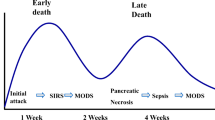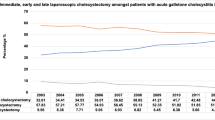Abstract
Purpose
Laparoscopic cholecystectomy (LC) is the treatment of choice for gallstones. There is an increased incidence of bile duct injuries in LC compared with the open technique. Isolated right segmental hepatic duct injury (IRSHDI) represents a challenge not only for management but also for diagnosis. We present our experience in the management of IRSHDI, with long-term follow-up after treatment by a multidisciplinary approach.
Methods
Twelve consecutive patients (9 women, mean age 48 years) were identified as having IRSHDI. Patients’ demographics, clinical presentation, management and outcome were collected for analysis. The mean follow-up was 44 months (range 2–90 months).
Results
Three patients had the LC immediately converted to open surgery without repair of the biliary injury before referral. Treatments before referral included endoscopic retrograde cholangiopancreatography (ERCP), percutaneous drainage and surgery, isolated or in combination. The median interval from LC to referral was 32 days. Eleven patients presented with biliary leak and biloma, one with obstruction of an isolated right hepatic segment. Post-referral management of the biliary lesion used a combination of ERCP stenting, percutaneous drainage and stent placement and surgery. In 6 of 12 patients ERCP was the first procedure, and in only one case was IRSHDI identified. In 6 patients, percutaneous transhepatic cholangiography (PTC) was performed first and an isolated right hepatic segment was demonstrated in all. The final treatment modality was endoscopic management and/or percutaneous drainage and stenting in 6 patients, and surgery in 6. The mean follow-up was 44 months. No mortality or significant morbidity was observed.
Conclusion
Successful management of IRSHDI after LC requires adequate identification of the lesion, and multidisciplinary treatment is necessary. Half of the patients can be treated successfully by nonsurgical procedures.




Similar content being viewed by others
References
SM Strasberg M Hertl NJ Soper (1995) ArticleTitleAn analysis of the problem of biliary injury during laparoscopic cholecystectomy J Am Coll Surg 180 101–125 Occurrence Handle1:STN:280:DyaK2M%2FptlOhuw%3D%3D Occurrence Handle8000648
AJ McMahon G Fullarton IN Baxter PJ O’Dwyer (1995) ArticleTitleBile duct injury and bile leakage in laparoscopic cholecystectomy Br J Surg 82 307–313 Occurrence Handle1:STN:280:DyaK2Mzhs1eksg%3D%3D Occurrence Handle10.1002/bjs.1800820308
AM Davidoff TN Pappas EA Murray et al. (1992) ArticleTitleMechanisms of major biliary injury during laparoscopic cholecystectomy Ann Surg 215 196–202 Occurrence Handle1:STN:280:DyaK387otFagtw%3D%3D Occurrence Handle10.1097/00000658-199203000-00002
KD Lillemoe JA Petrofski MA Choti AC Venbrux JL Cameron (2004) ArticleTitleIsolated right segmental hepatic duct injury: A diagnostic and therapeutic challenge J Gastrointest Surg 4 168–177 Occurrence Handle10.1016/S1091-255X(00)80053-0
H Bismuth (1982) Postoperative strictures of the bile duct LH Blumgart (Eds) The Biliary Tract Edinburgh Churchill Livingston 209–218
InstitutionalAuthorNameSouthern Surgeons Club (1991) ArticleTitleA prospective analysis of 1518 laparoscopic cholecystectomies N Engl J Med 324 1073–1078 Occurrence Handle10.1056/NEJM199104183241601
VS Lee RS Chari G Cucchiaro WC Meyers (1993) ArticleTitleComplications of laparoscopic cholecystectomy Am J Surg 165 527–532 Occurrence Handle1:STN:280:DyaK3s3ktlGnsw%3D%3D Occurrence Handle10.1016/S0002-9610(05)80955-9
WC Meyers DS Peterseim TN Pappas (1996) ArticleTitleLow insertion of hepatic segmental duct VII–VIII is an important cause of major biliary injury or misdiagnosis [see comments] Am J Surg 171 187–191 Occurrence Handle1:STN:280:DyaK287kt1Wisg%3D%3D Occurrence Handle10.1016/S0002-9610(99)80097-X
IB Schipper EA Rauws DJ Gouma H Obertop (1996) ArticleTitleDiagnosis of right hepatic duct injury after cholecystectomy: The use of cholangiography through percutaneous drainage catheters Gastrointest Endosc 44 350–354 Occurrence Handle1:STN:280:DyaK2s%2FjvFyitQ%3D%3D Occurrence Handle10.1016/S0016-5107(96)70181-5
RA Christensen E vanSonnenberg AAJ Nemcek HB D’Agostino (1992) ArticleTitleInadvertent ligation of the aberrant right hepatic duct at cholecystectomy: Radiologic diagnosis and therapy Radiology 183 549–553 Occurrence Handle1:STN:280:DyaK383itV2qtw%3D%3D Occurrence Handle10.1148/radiology.183.2.1561367
EL Pollack J Tabrisky (1973) ArticleTitleThe aberrant divisional bile duct: A surgical hazard Surgery 73 234–239 Occurrence Handle1:STN:280:DyaE3s%2FoslGhsw%3D%3D Occurrence Handle4684831
SG Puente GC Bannura (1983) ArticleTitleRadiological anatomy of the biliary tract: Variations and congenital abnormalities World J Surg 7 271–276 Occurrence Handle1:STN:280:DyaL3s3ltFWrsg%3D%3D Occurrence Handle10.1007/BF01656159
DF Mirza KL Narsimhan BH Ferraz Neto AD Mayer P McMaster JA Buckels (1997) ArticleTitleBile duct injury following laparoscopic cholecystectomy: Referral pattern and management Br J Surg 84 786–790 Occurrence Handle1:STN:280:DyaK2szjt12htw%3D%3D Occurrence Handle9189087
FP Schol PM Go DJ Gouma (1994) ArticleTitleRisk factors for bile duct injury in laparoscopic cholecystectomy: Analysis of 49 cases Br J Surg 81 1786–1788 Occurrence Handle1:STN:280:DyaK2M7ivVOntQ%3D%3D Occurrence Handle10.1002/bjs.1800811225
C Kalayci A Aisen D Canal et al. (2000) ArticleTitleMagnetic resonance cholangiopancreatography documents bile leak site after cholecystectomy in patients with aberrant right hepatic duct where ERCP fails Gastrointest Endosc 52 277–281 Occurrence Handle1:STN:280:DC%2BD3cvlslymtA%3D%3D Occurrence Handle10.1067/mge.2000.107217
PHP Davids EAJ Rauws GNJ Tytgat K Huibregtse (1992) ArticleTitlePostoperative bile leakage: Endoscopic management Gut 33 1118– 1122 Occurrence Handle1:STN:280:DyaK3s%2FhtlWmuw%3D%3D Occurrence Handle10.1136/gut.33.8.1118
DR Fletcher MS Hobbs P Tan et al. (1999) ArticleTitleComplications of cholecystectomy: Risks of the laparoscopic approach and protective effects of operative cholangiograph A population-based study. Ann Surg 229 449–457 Occurrence Handle1:STN:280:DyaK1M3hslOhtw%3D%3D Occurrence Handle10203075
R Uflacker GS Mourão RL Piske S Lima (1989) ArticleTitlePercutaneous transhepatic biliary drainage: Alternatives in left hepatic duct obstruction Gastrointest Radiol 14 137–142 Occurrence Handle1:STN:280:DyaL1M3htFOksQ%3D%3D Occurrence Handle10.1007/BF01889178
Author information
Authors and Affiliations
Corresponding author
Rights and permissions
About this article
Cite this article
Perini, R.F., Uflacker, R., Cunningham, J.T. et al. Isolated Right Segmental Hepatic Duct Injury Following Laparoscopic Cholecystectomy. Cardiovasc Intervent Radiol 28, 185–195 (2005). https://doi.org/10.1007/s00270-004-2678-5
Published:
Issue Date:
DOI: https://doi.org/10.1007/s00270-004-2678-5




